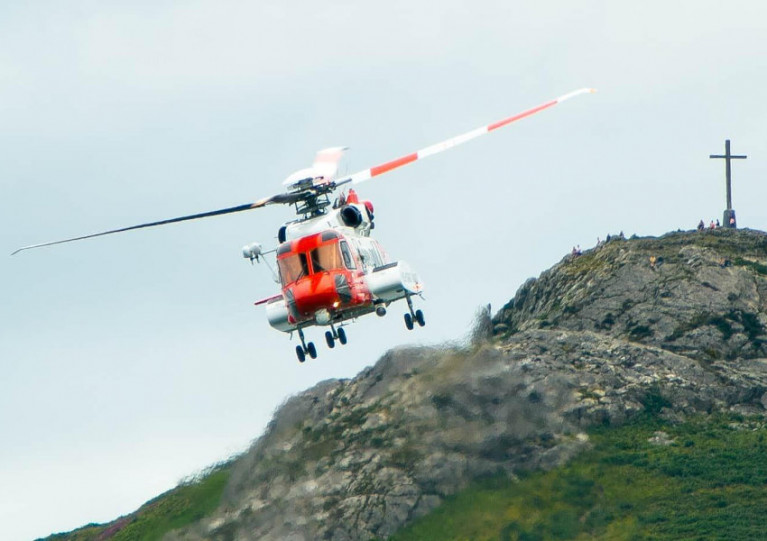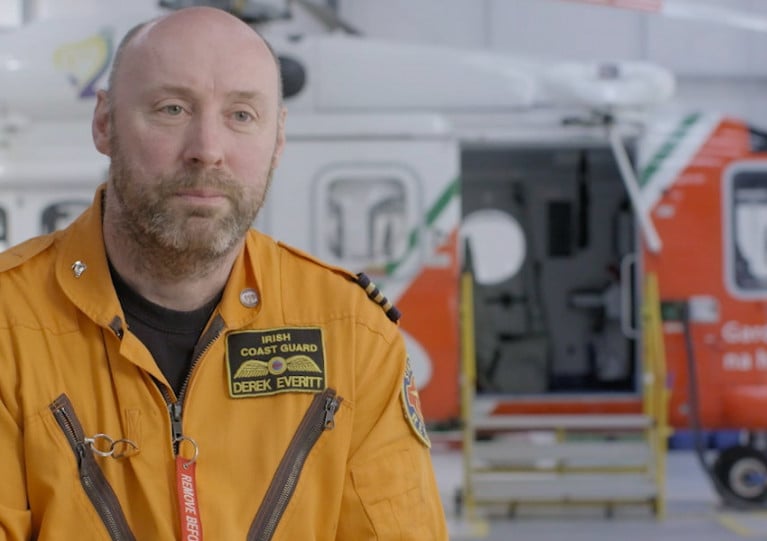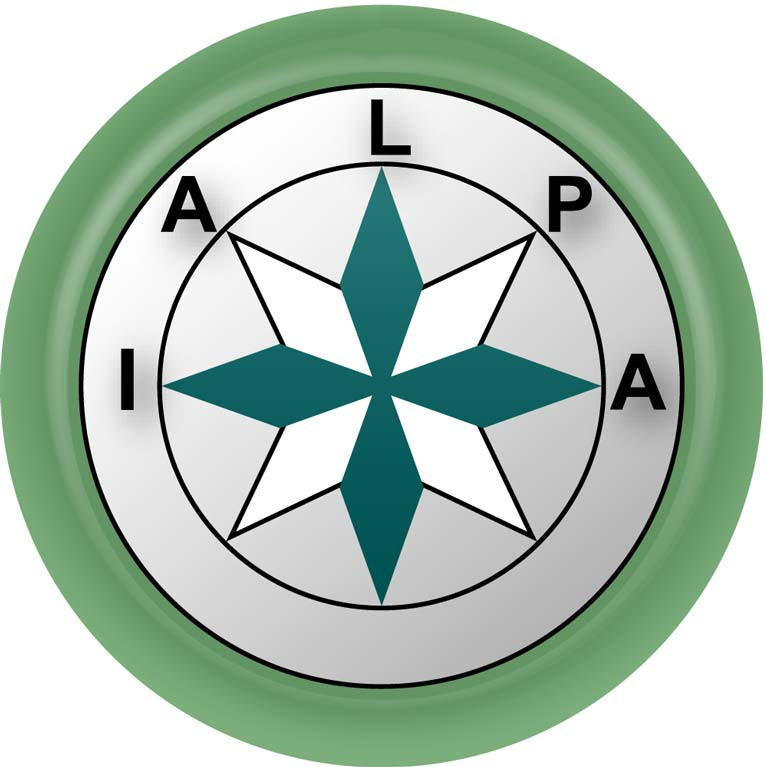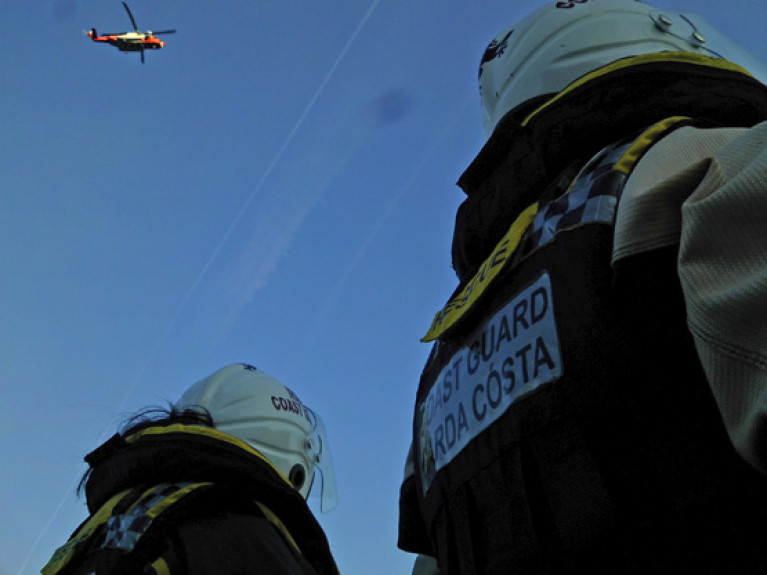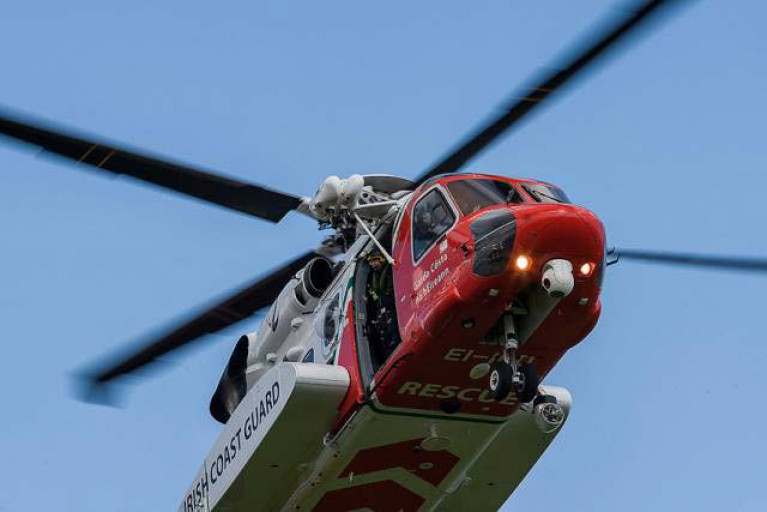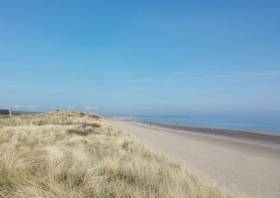Displaying items by tag: Rescue 116
In the absence of this year’s Bray Air Display due to the coronavirus pandemic, the Irish Coast Guard’s Dublin-based helicopter Rescue 116 conducted a special fly-past to pay tribute to Ireland’s frontline healthcare workers.
The Sikorsky S92 helicopter took to the skies over the Co Wicklow town at 3pm yesterday, Saturday 25 July, on the same afternoon it flew to the rescue of a family of four stranded by the tide at Sandymount.
Rob Tatten, general operations manager of CHC Ireland, which operates the coastguard’s SAR helicopter service, was in attendance to make small presentation to Mr Paul Reid, chief executive of the HSE, and spoke before the event.
He said: “CHC, who operates the helicopter search and rescue contract on behalf of the Irish Coast Guard, has been taking part in the Bray Air Display every year. However due to the pandemic that wasn’t possible this year.
“But with the organisers of the show we said could we do something to recognise the phenomenal work of our fellow frontline healthcare workers, who like us continue to work 24/7, 365 days a year.
“So today, Rescue 116, while out training, will do a fly-past to thank those workers while we also make a short presentation to Paul Reid and other frontline workers to say thank you on behalf of CHC, the Irish Coast Guard, the aviation community and Bray Air Display.”
The Irish Coast Guard’s Dun Laoghaire unit launched to the rescue of a family of four cut off by the tide on Sandymount yesterday afternoon, Saturday 25 July.
Dun Laoghaire Coast Guard were tasked to incident along with the local RNLI’s inshore lifeboat and the Dublin-based coastguard helicopter Rescue 116.
The two adults and two children were retrieved from their sandbank by the helicopter crew, who landed them at a safe spot on land where they wiremen by a coastguard team. All were found to be in good spirts.
Emergency services remind the public if you see anyone in difficulty in or near the water to dial 112/999 immediately and ask for the coastguard.
Vertical Magazine has shared video of a roundtable discussion on helicopter rescues from earlier this year, featuring a member of the Rescue 116 crew with the Irish Coast Guard.
Helicopter winchman Derek Everitt was in attendance at the HAI Heli-Expo in Anaheim, California this past January, where he took part in a talk with fellow professionals about their ‘life on the wire’.
He was joined by Montana-based air rescue specialist Wil Milam, fire rescue pilot Tony Webber, Canadian rescuer Rob Munday, Las Vegas police flight instructor Dave Callen and hoist operator and paramedic Jason Connell.
The wide-ranging discussion, which can be seen in the video above, included their most memorable rescues — and some of the biggest mistakes they’ve learned from.
For Everitt, his most memorable “screw-up” was as young crewman with the Air Corps involved an unplanned landing at a mountain crossroads for his pilot to impress a high-ranking friend — with embarrassing results.
Vertical has much more on the story HERE.
State's Air Navigation Division Suffering Staff Shortages Two Years After Rescue 116 Crash, Review Finds
Air navigation services run by the Irish Aviation Authority (IAA) have not been adequately resourced and were still suffering from staffing shortages for at least two years after the Rescue 116 helicopter crash, The Sunday Independent reports.
A review for the Department of Transport also calls for a "just culture body" which is "robust" to be implemented as soon as possible to protect pilots and other crew members who make confidential reports on safety concerns.
And it criticises delays in separating the State aviation authority's conflicting functions of safety regulation and commercial operations.
The lack of accurate air navigation charts available to Irish Coast Guard helicopter search and rescue crews was one of the key issues highlighted after the Rescue 116 crash which claimed the lives of Capt Dara Fitzpatrick, Capt Mark Duffy, Paul Ormsby and Ciaran Smith off north Co Mayo on March 14, 2017.
The final report into the crash has still not been published as an unidentified stakeholder has been granted a review of the final draft report by Minister for Transport Shane Ross.
In late 2017, the IAA had invited search and rescue and other pilots to help correct aeronautical charts after it conceded charts published three months after the crash were inaccurate, with lighthouses in wrong locations and obscure symbols.
Although the IAA is responsible for providing aeronautical charts under State safety plans, it has said it does not guarantee their accuracy or completeness and disclaims all liability.
The review of the IAA technical and safety performance by Helios and Egis Avia consultants during the second and third quarters of 2019 found the IAA air navigation division staff were having to work "extended hours", as posts could not be filled after one inspector left and one took maternity leave.
The "slow pace" of separating safety regulation from money-making commercial activities within the IAA and the potential workload increase for IAA staff as a result of Brexit are other issues flagged in the review.
For more, read The Sunday Independent report here
The Irish Coast Guard has issued a statement marking three years since the loss of four crew of the helicopter Rescue 116 off Co Mayo.
Capt Dara Fitzpatrick, Capt Mark Duffy, and winch crew Paul Ormsby and Ciarán Smith died when their Sikorsky S-92 hit Blackrock island off north Mayo in the early hours of 14 March 2017. The bodies of Ormsby and Smith have not been found to date.
The coastguard said: “As our frontline and emergency service workers yet again distinguish themselves during this current crisis, we remember Dara, Mark, Paul and Ciarán who we lost three years ago today. Four of Ireland’s finest stepped out into the darkness to come to the aid of strangers.
“Two brave souls were brought home, two remain lost to the sea, but all four will be forever remembered for the sacrifice they made. Our thoughts today are with the families, friends and colleagues of Dara, Mark, Paul and Ciarán.
“Go Mairidís Beo.”
Last night, Belfast Coastguard paid respects to their colleagues in the Republic, stating: “Three years on the sense of loss and disbelief is still very much real for us all. Tonight especially, we remember the crew and their families.”
And in a touching tribute following a tidal cutoff rescue yesterday (Friday 13 March), the crew of the helicopter now using the Rescue 116 callsign left a special signature of a heart in the sky to remember those lost.
Afloat.ie reported on Thursday (12 March) that a senior counsel has been appointed to chair a review into aspects of the State investigator’s final report on the 2017 helicopter crash.
Pilots' Union Says Review of Rescue 116 Final Report in Conflict With International Safety Standards
The Irish Airline Pilots’ Association has said the Government’s establishment of a review board into the Rescue 116 helicopter crash draft final report is in conflict with international safety standards writes Lorna Siggins
The pilots’ union was responding to Wednesday’s announcement by Minister for Transport Shane Ross that he was appointing senior counsel Patrick McCann to chair the review of the draft final report.
The draft has been completed and was circulated last autumn to interested parties, including families of the four crew who died - Capt Dara Fitzpatrick, Capt Mark Duffy, and winch crew Paul Ormsby and Ciarán Smith.
A 60-day period was given for submissions. However, the report has not yet been published by Ireland’s Air Accident Investigation Unit (AAIU), due to an application in January for a review of certain findings. An interim statement was issued by the AAIU this week in the lead up to the third anniversary of the crash ( March 14).
The four air/sea rescue helicopter crew were providing “top cover” communication for the medical evacuation of a crewman from a British-registered fishing vessel when their Sikorsky S-92 hit Blackrock island off north Mayo in the early hours of March 14, 2017.
The bodies of the helicopter’s two winch crew have not been found to date in spite of extensive searches supported by the Irish fishing fleet.
IALPA president Capt Evan Cullen has expressed concern over the ongoing delay in publishing the final report.
“Ireland has an obligation to publish the final version of an accident investigation report as quickly as possible to ensure that safety recommendations, potentially applicable to search and rescue operations worldwide, are implemented at the earliest possible opportunity,” Capt Cullen said.
Cap Cullen said that in IALPA’s view, the review “does not comply with the standards and recommended practices laid down by the International Civil Aviation Organisation (ICAO)”.
“Annex 13 of ICAO sets out how states should investigate or delegate the investigation of accidents which have occurred in their territory,” he said.
“For a country to take the unusual step of deviating from ICAO practice, it must file a difference to the ICAO standards and we do not believe Ireland has taken this step,” he said.
“It is fundamental that adherence to international obligations regarding aviation safety recommendations should transcend stakeholder concerns over reputation. Prevention of any future accidents demands no less,” he added.
The Department of Transport said it "wholly rejects" the IALPA claim and said there was "nothing in Annexe 13 of the ICAO regulations " that obliged it to file a difference. A spokeswoman for the department said the AAIU chief inspector also concurred with its position.
Under Ireland’s Air Navigation (Notification and Investigation of Accidents, Serious Incidents and Incidents) Regulations 2009, an “interested party” may serve on the minister written “notice of re-examination”.
This is “in respect of findings and conclusions that appear to reflect adversely on the person’s reputation”.
CHC Ireland, which employed the four aircrew, has declined to say whether it sought the review.
Almost three years after four Irish Coast Guard aircrew lost their lives in a helicopter crash off the north Mayo coast, a senior counsel has been appointed to chair a review into aspects of the State investigator's final report writes Lorna Siggins
Minister for Transport Shane Ross has appointed senior counsel Patrick McCann to chair the review of the draft final report which has not yet been published by the Air Accident Investigation Unit (AAIU).
Mr McCann will be assisted by an “independent expert member”, Mr Ross said on Wednesday in a statement announcing the establishment of the review board – two months after it was first sought.
Mr Ross said that the review board would “re-examine certain findings of the draft final report”.
Mr Ross’s department had confirmed back in early January that a review had been requested by a “stakeholder”, which it would not identify.
It said then that “arrangements are being put in place” to set this board up, and confirmed the review would be held in private.
CHC Ireland, which employed the four air crew who died – Capt Dara Fitzpatrick, Capt Mark Duffy, and winch crew Paul Ormsby and Ciarán Smith - declined to say whether it sought the review.
The four air/sea rescue helicopter crew died when their Sikorsky S-92 hit Blackrock island off north Mayo in the early hours of March 14, 2017. The bodies of Ormsby and Smith have not been found to date.
Under the Air Navigation (Notification and Investigation of Accidents, Serious Incidents and Incidents) Regulations 2009, an “interested party” may serve on the minister written “notice of re-examination”.
This is “in respect of findings and conclusions that appear to reflect adversely on the person’s reputation”.
CHC Ireland holds the ten-year Irish Coast Guard search and rescue contract, which is worth €50m a year and is due to expire in 2022, though an extension could be allowed to 2025. Work has already begun on preparing a new tender.
The AAIU ruled out mechanical failure early on in its preliminary report into the crash, and an interim report was published a year after the crash. An interim statement was published on March 1st, 2019.
The AAIU has already identified in its preliminary report that the Dublin-based crew were flying with inaccurate chart information and faulty installation of satellite locators in the pilots’ lifejackets.
Rescue 116 had been tasked on the night of March 13th 2017 to provide “top cover” support to the Sligo-based Rescue 118 helicopter for a medical evacuation off the west coast. It was approaching Blacksod lighthouse to refuel when it collided with Blackrock island nine nautical miles to the west.
The AAIU’s draft final report was issued on September 13th, 2019 to “interested parties”, including the four bereaved families and CHC Ireland. The parties were given 60 days to review this report and offer comments.
“The review board will be chaired by senior counsel Patrick McCann who will be assisted by an independent expert member. The review board will be entirely independent in its work in accordance with the relevant legislation,” Mr Ross’s statement said.
The AAIU said last January that it would continue to handle submissions in relation to the draft conclusions.
The review board’s chair must be a barrister or solicitor of 10 years’ standing, or a person who, in the minister’s opinion, has “aeronautical or engineering knowledge”.
The Minister may also appoint one or more technical assessors. A report is compiled for the minister if the re-examination proceeds.
New TG4 Documentary Reaches Into Heart & Soul Of Irish Coast Guard
Following January’s film on Ireland’s offshore fishing industry, the latest episode of TG4 documentary series Tabú reaches into the heart and soul of the Irish Coast Guard — as told by the coastguard members in their own words.
In the aftermath of the loss of Rescue 116 and volunteer Caitríona Lucas, An Garda Cósta - Ár n-Insint Féin, which screens this coming Wednesday 4 March, explores how they continue to serve in spite of the tragedies.
Focusing on operations after the biggest tragedy that has happened to any Blue Light service in Ireland, the hour-long film reveals the anguish of the search, along with the coping mechanisms of “the coastguard family”.
And according to the producers, the documentary also reveals the dangers of the job and how they stay on the right side of risk.
Produced and directed by Darina Clancy for Midas Productions, Tabú: An Garda Cósta - Ár n-Insint Féin broadcasts Wednesday 4 March at 9.30pm on TG4.
The Minister for Transport’s approval of a review of the Air Accident Investigation Unit’s draft final report into the Rescue 116 helicopter crash has been described as “unprecedented” by the Irish Airline Pilots’ Association (IALPA) writes Lorna Siggins.
The pilots’ union has expressed concern that the delay in publishing the final Rescue 116 report and an imminent general election may set back “urgent reform” of Irish aviation regulation.
CHC Ireland has declined to comment on whether it sought the review, which is permitted under the Air Navigation (Notification and Investigation of Accidents, Serious Incidents and Incidents) Regulations 2009.
It is the first time in the AAIU’s 25-year history that the review option has been sought before a final report is issued.
The helicopter company employed the four aircrew – pilots Dara Fitzpatrick, Mark Duffy, Paul Ormsby and Ciarán Smith – who died when their Sikorsky S-92A helicopter hit Blackrock island off north Mayo in the early hours of March 14th, 2017.
The bodies of Paul Ormsby and Ciarán Smith remain missing, in spite of extensive searches.
The Department of Transport said it could not confirm which “party” requested the review, as reported in The Sunday Times today here.
CHC said it “continues to engage fully with the investigation and remain committed to complying with our obligation to avoid commenting on any aspect of the final report”.
CHC Ireland is holder of the 500 million euro Irish Coast Guard search and rescue contract, which is due to expire in 2022 – though an extension could be allowed to 2025- and work has already begun on preparing a new tender.
The Department of Transport confirmed that arrangements are being made for the review of the draft final report, which was released to interested parties last autumn for comment within 60 days.
The AAIU does not seek to apportion liability or blame, but lack of oversight by the Irish Aviation Authority and management failures by the Irish Coast Guard and CHC have already emerged as factors.
The preliminary report published in April 2017 identified faulty navigation systems and incorrectly fitted satellite locator beacons on the lifejackets of the two pilots.
The Dublin-based crew had been tasked to provide “top cover” support to the Sligo-based Rescue 118 helicopter for a medical evacuation off the west coast.
Stakeholders were informed on January 8th of a delay in publishing the final report, when the AAIU confirmed that an “interested party” “had “served written notice of re-examination on the Minister for Transport...on specific findings and conclusions contained in the draft final report”.
Regulation 15 (1) of the Air Navigation Regulations 2009 allows for a re-examination of “any findings and conclusions in that report that appear to reflect adversely on the person’s reputation or on the reputation of any person, living or dead, whose executor, administrator or other representative he or she is”.
The report’s delayed publication, along with an anticipated general election, means legislation which would transfer air navigation functions from the IAA to a new Irish Air Navigation Authority is in danger of “sliding down the legislative agenda”, Ialpa president Capt Evan Cullen said this weekend (sat).
“This Bill includes vital reforms to aviation regulation which are essential to bring Ireland into line with European aviation safety norms,”Capt Cullen said, calling on the Government to make it a priority.
Capt Cullen noted that the Minister for Transport had committed as far back as August 2015 to restructure the regulatory functions of IAA, but progress had been “protracted”.
The IAA currently has a “conflict of interest” in holding a safety mandate for regulatory oversight while it also “makes money out of the same entities that it regulates”, he said.
“The aviation industry in Ireland should be a cause of pride. However, Ireland’s aviation regulator remains an outlier in terms of its corporate structure,” Capt Cullen said.
“ The framework of the IAA is so outdated it is undermining Ireland’s reputation for upholding safety standards. This needs to be urgently addressed,” he said.
“Once this bill is initiated, we urge the party whips in the Dáil and Seanad to commit to agreeing to prioritise the passage of the bill so as to facilitate its enactment in advance of the general election,” Capt Cullen said.
The chair of the review board for the AAIU’s final draft report must be a barrister or solicitor of no less than ten years’ standing or a person who, in the minister’s opinion, has “aeronautical or engineering knowledge or other special knowledge or experience of air navigation or aviation”.
The review will be held in private, with the applicant given 21 days’ notice. A report is then compiled for the minister if the re-examination proceeds.
For more, read The Sunday Times here
TheJournal.ie is reporting along with other news outlets that a teenage girl has died after getting into difficulty swimming off a Co Louth beach yesterday (friday 28 June).
The 14-year-old girl was reportedly pulled out to sea by a rip current while swimming off a beach in Termonfeckin, north-east of Drogheda.
A winch man from the Irish Coast Guard’s Rescue 116 helicopter recovered the girl from the water and she was airlifted from the beach to hospital in Drogheda, where she was later pronounced dead.
Onlookers at the beach shared their distress over the incident with the Irish Independent.


























